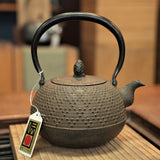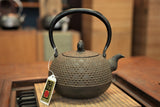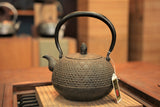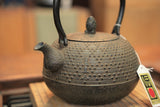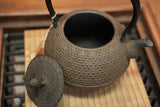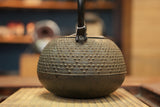DESCRIPTION
Allow us to present a unique Tetsubin that hails not from Oitomi, but rather from the craftsmanship of Shingo Kikuchi (菊池真吾), a traditional artisan based in Shokado. His atelier is situated in Oshu City, Iwate Prefecture, the same locale as our own.
The appellation of "traditional craftsman" carries official recognition by the Japanese government, signifying those who possess and uphold advanced techniques and skills. Among the limited ranks of traditional craftsmen in Nambu Ironware, Shingo Kikuchi stands as a prominent figure.
Nambu ironware is meticulously forged through two distinctive methodologies: Nama-gata, involving sand molds, and Yaki-gata, characterized by molds fashioned from baked clay. This Tetsubin, shaped by the Yaki-gata technique, emerges as an exceedingly rare creation, with only a few pieces being attainable from a single mold.
Its circular and endearing silhouette is adorned with the Uroko-arare pattern. The lid, too, features an exquisite pine cone motif adorning its edge.
The term "UROKO" denotes a pattern constituted by continuous arrangements of equilateral or isosceles triangles, symbolizing "scales" in Japanese. This nomenclature stems from the interconnected triangles, resembling the scales of a fish. Noteworthy for its popularity on iron kettles, this pattern also graces the design of kimono fabrics.
Within, a technique known as kama-yaki imparts an oxidized film to the interior, meticulously achieved without the application of any paint. Some sections may exhibit reddish hues, a natural consequence of the kama-yaki process.
While this Tetsubin may command a higher price point compared to its counterparts, its distinction arises from the Yaki-gata method, its bold and traditional aesthetic compositions, and the intimate inscription of the traditional craftsman, "南部 真吾" (Nambu Shingo), ensuring that this special Tetsubin shall remain your lifelong companion.
Please note that this item is also available at our physical store, with stock availability potentially varying based on timing. Kindly acknowledge that there might be instances where an ordered item is temporarily out of stock.
Additionally, we kindly advise that due to the handmade nature of each piece, subtle divergences may exist between the actual product and the photographs.
To make tea and coffee great

INTERNATIONAL SHIPPING
International Shipping Available
All items are eligible for international shipping.
Items are manufactured after receiving orders and will be shipped from Japan in about 1-2 months(Maximum 3 months for items labeled "made-to-order").
The schedule may be revised depending on destination countries, shipping companies, and changes of customs rules.
CUSTOMS DUTY
About Customs Duties and Taxes
Your final payment on our website includes the price of the product and shipping costs, but does not include any other fees required for international shipping, such as import taxes, customs duties, and other fees.
Please be aware that in all cases you are responsible for paying any import fees applied to your order.
These fees are set in detail for each country and region, and the rules are revised frequently. Please make sure that information is up to date when you place an order.
Refunds due to customs or import issues that are not our responsibility will not be accepted.


 Skip to content
Skip to content









